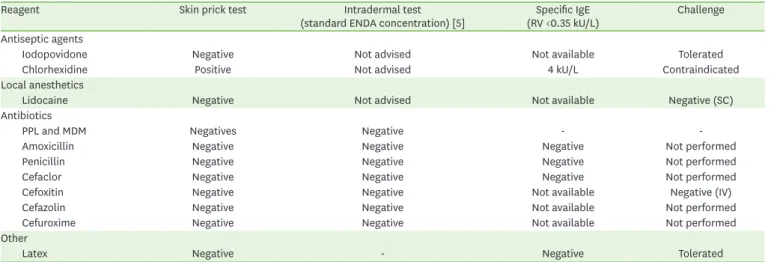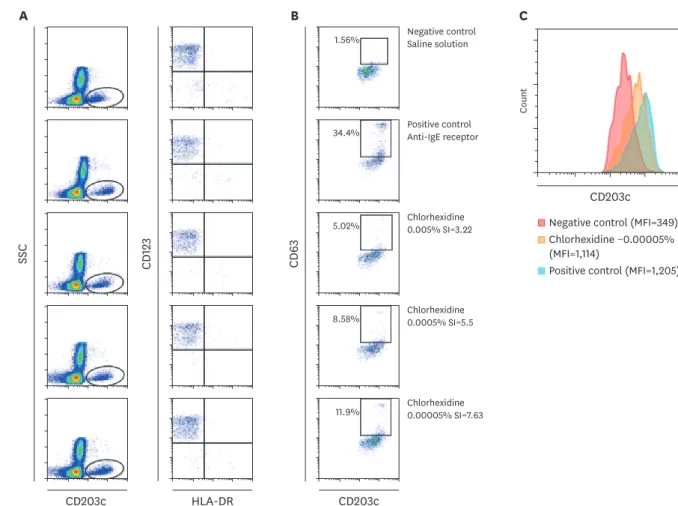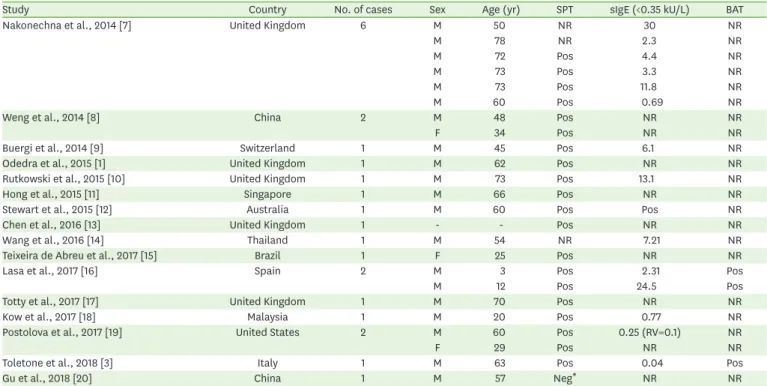ABSTRACT
Chlorhexidine is a commonly used antiseptic and disinfectant in the health-care setting.
Anaphylaxis to chlorhexidine is a rare but potentially life-threatening complication.
Epidemiologic data suggest that the cases of chlorhexidine allergy appears to be increasing.
In this article we report a life-threatening anaphylactic shock with cardiorespiratory
arrest, during urethral catheterization due to chlorhexidine. The authors also performed
a literature review of PubMed library of anaphylactic cases reports due to this antiseptic
between 2014 and 2018, demonstrating the increase in the number of cases occurring
worldwide and the importance of detailed anamnesis and appropriate diagnostic workup of
allergic reactions to disinfectants.
Keywords:
Allergy; Anaphylaxis; Chlorhexidine
INTRODUCTION
Chlorhexidine is an antiseptic and disinfectant used against a broad of bacteria, viruses and
fungi [1]. Since its introduction in 1954, it is used in the hospital settings for medical and
surgical products and widely in over-the-counter products [1, 2]. Many health professionals
are unaware of its presence in different products, so it is often a ‘hidden’ allergen.
The most common allergic reactions described to chlorhexidine are delayed reactions (type
IV hypersensitivity), T cell mediated, and occur after exposure to the antiseptic for topical
use. Contact dermatitis is the most frequent manifestation [2-4]. Immediate reactions (type I
hypersensitivity), have also been reported, but much less frequently, and symptoms can range
from urticaria to anaphylaxis with a risk of cardiorespiratory arrest and death [2-4].
It has not been described cross reactivity between chlorhexidine and other antiseptic agents [1].
Educational &
Teaching Material
Received: May 15, 2019 Accepted: Jul 30, 2019 *Correspondence to Mara FernandesServiço de Imunoalergologia, Hospital de Santa Maria, Centro Hospitalar Universitário Lisboa Norte, Av. Prof. Egas Moniz s/n, 1649-035 Lisboa, Portugal.
Tel: +351-21-780-5000 Fax: +351-21-780-5610
E-mail: maravfernandes@gmail.com Copyright © 2019. Asia Pacific Association of Allergy, Asthma and Clinical Immunology. This is an Open Access article distributed under the terms of the Creative Commons Attribution Non-Commercial License (https:// creativecommons.org/licenses/by-nc/4.0/) which permits unrestricted non-commercial use, distribution, and reproduction in any medium, provided the original work is properly cited.
ORCID iDs Mara Fernandes
https://orcid.org/0000-0003-0466-6128 Conflict of Interest
The authors have no financial conflicts of interest.
Author Contributions
Conceptualization: Mara Fernandes, Tatiana Lourenço, Anabela Lopes, Amélia Spínola Santos, Maria Conceição Pereira Santos. Data curation: Mara Fernandes, Tatiana Lourenço. Investigation: Mara Fernandes, Tatiana Lourenço, Anabela Lopes, Amélia Spínola Santos, Maria Conceição Pereira Santos.
Mara Fernandes
1,2,*, Tatiana Lourenço
1, Anabela Lopes
1, Amélia Spínola Santos
1,
Maria Conceição Pereira Santos
3,4, and Manuel Pereira Barbosa
1,41 Serviço de Imunoalergologia, Hospital de Santa Maria, Centro Hospitalar Universitário Lisboa Norte EPE,
Portugal
2Unidade de Imunoalergologia, Hospital Dr. Nélio Mendonça, SESARAM EPE, Funchal, Portugal 3 Laboratório de Imunologia Clínica, Instituto de Medicina Molecular, Faculdade de Medicina da
Universidade de Lisboa, Portugal
4Clínica Universitária de Imunoalergologia, Faculdade de Medicina da Universidade de Lisboa, Portugal
Chlorhexidine: a hidden life-threatening
allergen
Supervision: Maria Conceição Pereira Santos, Manuel Pereira Barbosa. Validation: Mara Fernandes, Amélia Spínola Santos. Writing - original draft: Mara Fernandes, Tatiana Lourenço, Anabela Lopes, Amélia Spínola Santos, Maria Conceição Pereira Santos. Writing - review & editing: Anabela Lopes, Amélia Spínola Santos, Maria Conceição Pereira Santos.
CASE REPORT
A 75-year-old male with hypertension receiving beta-blocker and bladder cancer underwent
transurethral tumor resection in 2014. Surveillance postsurgical cystoscopy under local
anesthesia was performed every 6 months. During the 2nd procedure he developed
generalized cutaneous pruritus with no other symptoms with spontaneous resolution after
one hour. This reaction was interpreted as allergy to cefoxitin and it was recommended to
avoid 2nd generation cephalosporins.
Twenty minutes after the 4th cystoscopy, he developed generalized urticaria, oropharyngeal
tightening, dyspnea, hypotension (75/40 mmHg) and loss of consciousness with
cardiorespiratory arrest. Cardiopulmonary resuscitation was initiated immediately with
endovenous administration of adrenaline (1 mg), clemastine (2 mg) and hydrocortisone
(200 mg) and orotracheal intubation with invasive ventilation. The patient recovered over
the next 2 hours and was extubated on the same day.
The patient was referred to the immunoallergology outpatient clinic and a complete workup
was performed. Local disinfection and anesthesia were performed with iodopovidone
(Betadine, Meda Manufacturing, Mérignac, France) and lidocaine + chlorhexidine gel
(Optilube, Optimum Medical Ltd., Leeds, United Kingdom). Prophylactic antibiotic therapy
was performed only in 2nd procedure (cefoxitin) and ortho-phthalaldehyde (Cidex, Medos
International SARL, Le Locle, Switzerland) was not used as cystoscope disinfectant.
The allergologic investigation revealed negative skin prick test (SPT) to iodopovidone
and latex, and negative cutaneous tests (standard concentration [5] to benzyl
penicilloyl-polylysine (PPL), minor determinant mixture (MDM), amoxicillin, penicillin, cefoxitin).
Specific IgE (sIgE) available (latex, penicillin, amoxicillin) were negative. Provocation tests to
lidocaine and cefoxitin were negative.
SPT to chlorhexidine (2%) was strongly positive (11 mm × 10 mm wheal), with a positive sIgE
- 4 kU/L (normal value: <0.35 kU/L). Table 1 summarizes the allergologic workup.
Table 1. Allergologic workup carried out in our immunoallergology outpatient clinic Reagent Skin prick test Intradermal test
(standard ENDA concentration) [5] (RV <0.35 kU/L)Specific IgE Challenge Antiseptic agents
Iodopovidone Negative Not advised Not available Tolerated
Chlorhexidine Positive Not advised 4 kU/L Contraindicated
Local anesthetics
Lidocaine Negative Not advised Not available Negative (SC)
Antibiotics
PPL and MDM Negatives Negative -
-Amoxicillin Negative Negative Negative Not performed
Penicillin Negative Negative Negative Not performed
Cefaclor Negative Negative Negative Not performed
Cefoxitin Negative Negative Not available Negative (IV)
Cefazolin Negative Negative Not available Not performed
Cefuroxime Negative Negative Not available Not performed
Other
Latex Negative - Negative Tolerated
We also performed a basophil activation test (BAT) using chlorhexidine digluconate 20%
(1062 mg/mL) at 0.05%, 0.005%, 0.005%, and 0.00005% [6]. The basophil population was
identified as HLA-DR-CD123+ CD203c+ cells and activation by CD63 expression. BAT was
positive at 0.005%, 0.0005%, and 0.00005% with activation of 5.02%, 8.58%, and 11.9%
and stimulation index of 3.22, 5.5, and 7.63 respectively (Fig. 1).
The diagnosis of severe allergic reaction to chlorohexidine was confirmed. The patient was
advised to avoid products containing chlorhexidine. Subsequent cystoscopy was uneventful
using lidocaine gel as local anesthetic and iodopovidone as disinfectant. Moreover, he was
informed to be aware of chlorhexidine as a component of over the counter products and the
need to avoid them.
DISCUSSION
The first case of anaphylaxis to chlorhexidine has been reported in 1984 in Japan [1, 3].
Although rare, the number of clinical case reports of anaphylaxis (type I hypersensitivity)
to this antiseptic is increasing. Odedra et al. [1] published that from 1994 to 2013, 65
case reports of chlorhexidine-related anaphylaxis were diagnosed. The majority was
Negative control Saline solution Positive control Anti-IgE receptor Chlorhexidine 0.005% SI=3.22 Chlorhexidine 0.0005% SI=5.5 Chlorhexidine 0.00005% SI=7.63
A
B
C
CD203c SSC CD123 HLA-DR CD 63 CD203c CD203c CountPositive control (MFI=1,205) Chlorhexidine −0.00005% (MFI=1,114)
Negative control (MFI=349) 1.56%
34.4%
5.02%
8.58%
11.9%
Fig. 1. Basophil activation test performed in whole blood. (A) Identification of basophil population in the lymphocyte-monocyte gate a SSC/CD203c+. (B) Flow cytometry dot plots of CD63 expression (%) on CD123+/HLA-DR-/CD203c+ cells. (C) Histogram showing the mean fluorescence intensity (MFI) median of CD203c expression. SI, stimulation index (ratio of stimulated/unstimulated basophils).
among surgical patients (urology and cardiothoracic) [6]. From 1984 to 2014, 36 cases of
perioperative anaphylaxis to chlorhexidine were published [2].
Most reactions have been reported after application of chlorhexidine to damaged skin surfaces
(wounds, burns, surgical incision); and to mucous membranes (urethra, eyes, nose) or after
insertion of medical devices (central venous catheters, CVC) impregnated with chlorhexidine [4].
The prevalence of perioperative anaphylaxis range from 0.05%–2% and is increasing [2]. True
incidence attributed to chlorhexidine is unknown, with several authors suggesting that is rare, but
some studies referring incidences ranging from 5.5% to 8.8% [2]. Sharp et al. (Australia, 2016)
[2] in a review to chlorhexidine-induced anaphylaxis in surgical patient (total of 68 anaphylactic
reactions) showed that most frequent cases occur due to the presence of chlorhexidine in urinary
catheter lubricant (n = 30 [44.12%]), CVC (n=24 [35.29%]) and topical solutions (n=11 [16.18%]).
It appears to occur more frequently in men with mean age of 58 years, previously reporting a
mild cutaneous reaction on chlorhexidine exposure [1].
Patients rarely have history of atopic disease. The clinical presentation is variable. In
most cases patients developed erythematous rash/urticarial at the time of reaction and
hypotension, with some presenting cardiorespiratory arrest [1, 2]. Bronchospasm is rarely
reported [1, 2]. Our patient was older than the mean presented, however the reaction
occurred during a cystoscopy. This procedure and the severity of the symptoms were similar
to the most commonly described.
To our knowledge, in the last five years (2014–2018), a total of 24 cases of
chlorhexidine-related anaphylaxis were published (Table 2). The male gender is the most affected (83%).
Table 2. Published cases of chlorhexidine-induced anaphylaxis between 2014–2018
Study Country No. of cases Sex Age (yr) SPT sIgE (<0.35 kU/L) BAT
Nakonechna et al., 2014 [7] United Kingdom 6 M 50 NR 30 NR
M 78 NR 2.3 NR
M 72 Pos 4.4 NR
M 73 Pos 3.3 NR
M 73 Pos 11.8 NR
M 60 Pos 0.69 NR
Weng et al., 2014 [8] China 2 M 48 Pos NR NR
F 34 Pos NR NR
Buergi et al., 2014 [9] Switzerland 1 M 45 Pos 6.1 NR
Odedra et al., 2015 [1] United Kingdom 1 M 62 Pos NR NR
Rutkowski et al., 2015 [10] United Kingdom 1 M 73 Pos 13.1 NR
Hong et al., 2015 [11] Singapore 1 M 66 Pos NR NR
Stewart et al., 2015 [12] Australia 1 M 60 Pos Pos NR
Chen et al., 2016 [13] United Kingdom 1 - - Pos NR NR
Wang et al., 2016 [14] Thailand 1 M 54 NR 7.21 NR
Teixeira de Abreu et al., 2017 [15] Brazil 1 F 25 Pos NR NR
Lasa et al., 2017 [16] Spain 2 M 3 Pos 2.31 Pos
M 12 Pos 24.5 Pos
Totty et al., 2017 [17] United Kingdom 1 M 70 Pos NR NR
Kow et al., 2017 [18] Malaysia 1 M 20 Pos 0.77 NR
Postolova et al., 2017 [19] United States 2 M 60 Pos 0.25 (RV=0.1) NR
F 29 Pos NR NR
Toletone et al., 2018 [3] Italy 1 M 63 Pos 0.04 Pos
Gu et al., 2018 [20] China 1 M 57 Neg* NR NR
SPT, skin prick test; BAT, basophil activation test; NR, not reported; Pos, positive; RV, reference value; Neg, negative. *The diagnosis was confirmed after the 2nd provocation test.
Mean age was 51 ± 15 years (range, 3–78 years) in agreement with what has already been
described. The majority of the diagnosis was established through SPT. Twenty-one patients
performed SPT, 20 were positive. The diagnosis in patient with negative SPT was determined
by positive provocation test. Fifteen patients performed sIgE and were all positive (mean, 7.12
kU/L; range, 0.04–30 kU/L). Only 3 performed BAT and were positive.
Our review showed that immediate type I allergic reactions to chlorhexidine are increasing,
with a mean of 4.8 cases/yr described over the last 5 years, comparing with the 3.25 cases/
yr referred in Odedra et al. [1] review over 20 years. This allows us to admit that true
incidence of chlorhexidine anaphylaxis is likely to be underestimated in view of its large
use as a disinfectant. Undervaluation of previous chlorhexidine reactions increases the
risk of a possibly fatal outcome for the patient after re-exposure in future medical-surgical
procedures.
A prompt referral to a specialist consultation and detailed allergy study is crucial. Detailed
history and diagnostic testing allow to confirm the diagnosis of chlorhexidine allergy.
REFERENCES
1. Odedra KM, Farooque S. Chlorhexidine: an unrecognised cause of anaphylaxis. Postgrad Med J 2014;90:709-14.
PUBMED | CROSSREF
2. Sharp G, Green S, Rose M. Chlorhexidine-induced anaphylaxis in surgical patients: a review of the literature. ANZ J Surg 2016;86:237-43.
PUBMED | CROSSREF
3. Toletone A, Dini G, Massa E, Bragazzi NL, Pignatti P, Voltolini S, Durando P. Chlorhexidine-induced anaphylaxis occurring in the workplace in a health-care worker: case report and review of the literature. Med Lav 2018;109:68-76.
PUBMED
4. Pemberton MN. Allergy to Chlorhexidine. Dent Update 2016;43:272-4.
PUBMED | CROSSREF
5. Brockow K, Garvey LH, Aberer W, Atanaskovic-Markovic M, Barbaud A, Bilo MB, Bircher A, Blanca M, Bonadonna B, Campi P, Castro E, Cernadas JR, Chiriac AM, Demoly P, Grosber M, Gooi J, Lombardo C, Mertes PM, Mosbech H, Nasser S, Pagani M, Ring J, Romano A, Scherer K, Schnyder B, Testi S, Torres M, Trautmann A, Terreehorst I; ENDA/EAACI Drug Allergy Interest Group. Skin test concentrations for systemically administered drugs -- an ENDA/EAACI Drug Allergy Interest Group position paper. Allergy 2013;68:702-12.
PUBMED | CROSSREF
6. Egner W, Helbert M, Sargur R, Swallow K, Harper N, Garcez T, Savic S, Savic L, Eren E. Chlorhexidine allergy in four specialist allergy centres in the United Kingdom, 2009-13: clinical features and diagnostic tests. Clin Exp Immunol 2017;188:380-6.
PUBMED | CROSSREF
7. Nakonechna A, Dore P, Dixon T, Khan S, Deacock S, Holding S, Abuzakouk M. Immediate hypersensitivity to chlorhexidine is increasingly recognised in the United Kingdom. Allergol Immunopathol (Madr) 2014;42:44-9.
PUBMED | CROSSREF
8. Weng M, Zhu M, Chen W, Miao C. Life-threatening anaphylactic shock due to chlorhexidine on the central venous catheter: a case series. Int J Clin Exp Med 2014;7:5930-6.
PUBMED
9. Buergi A, Jung B, Padevit C, John H, Ganter MT. Severe anaphylaxis: the secret ingredient. A A Case Rep 2014;2:34-6.
PUBMED | CROSSREF
10. Rutkowski K, Wagner A. Chlorhexidine: a new latex? Eur Urol 2015;68:345-7.
11. Hong CC, Wang SM, Nather A, Tan JH, Tay SH, Poon KH. Chlorhexidine anaphylaxis masquerading as septic shock. Int Arch Allergy Immunol 2015;167:16-20.
PUBMED | CROSSREF
12. Stewart M, Lenaghan D. The danger of chlorhexidine in lignocaine gel: a case report of anaphylaxis during urinary catheterisation. Australas Med J 2015;8:304-6.
PUBMED | CROSSREF
13. Chen P, Huda W, Levy N. Chlorhexidine anaphylaxis: implications for post-resuscitation management. Anaesthesia 2016;71:242-3.
PUBMED | CROSSREF
14. Wang ML, Chang CT, Huang HH, Yeh YC, Lee TS, Hung KY. Chlorhexidine-related refractory anaphylactic shock: a case successfully resuscitated with extracorporeal membrane oxygenation. J Clin Anesth 2016;34:654-7.
PUBMED | CROSSREF
15. Teixeira de Abreu AP, Ribeiro de Oliveira LR, Teixeira de Abreu AF, Ribeiro de Oliveira E, Santos de Melo Ireno M, Aarestrup FM, Aarestrup MF, Aarestrup PF. Perioperative anaphylaxis to chlorhexidine during surgery and septoplasty. Case Rep Otolaryngol 2017;2017:9605804.
PUBMED | CROSSREF
16. Lasa EM, González C, García-Lirio E, Martínez S, Arroabarren E, Gamboa PM. Anaphylaxis caused by immediate hypersensitivity to topical chlorhexidine in children. Ann Allergy Asthma Immunol 2017;118:118-9.
PUBMED | CROSSREF
17. Totty J, Forsyth J, Mekako A, Chetter I. Life-threatening intraoperative anaphylaxis as a result of chlorhexidine present in Instillagel. BMJ Case Rep 2017;2017:pii: bcr-2017-221443.
PUBMED
18. Kow RY, Low CL, Ruben JK, Zaharul-Azri MZ, Ng MS. Life-threatening chlorhexidine anaphylaxis: a case report. Malays Orthop J 2017;11:72-4.
PUBMED | CROSSREF
19. Postolova A, Bradley JT, Parris D, Sherr J, McGhee SA, Hernandez JD. Anaphylaxis to invasive
chlorhexidine administration despite tolerance of topical chlorhexidine use. J Allergy Clin Immunol Pract 2018;6:1067-1069.e1.
PUBMED | CROSSREF
20. Gu JQ, Liu S, Zhi YX. Provocation Test-confirmed chlorhexidine-induced anaphylaxis in dental procedure. Chin Med J (Engl) 2018;131:2893-4.


